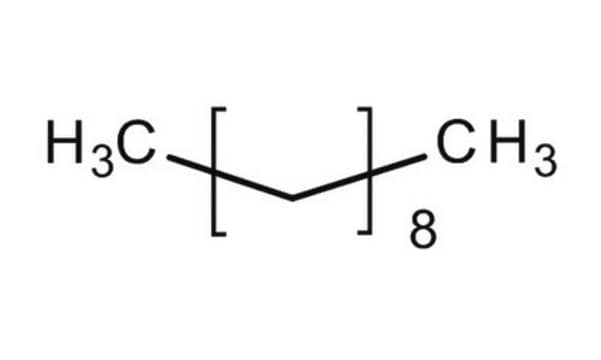30570
Decane
≥95%
Sinónimos:
n-Decane
About This Item
Productos recomendados
densidad de vapor
4.9 (vs air)
presión de vapor
1 mmHg ( 16.5 °C)
3.77 mmHg ( 37.7 °C)
Análisis
≥95%
formulario
liquid
temp. de autoignición
410 °F
lim. expl.
2.6 %
índice de refracción
n20/D 1.411 (lit.)
n20/D 1.412
bp
170.0-182.0 °C
174 °C (lit.)
mp
−30 °C (lit.)
densidad
0.730 g/mL at 20 °C
0.73 g/mL at 25 °C (lit.)
cadena SMILES
CCCCCCCCCC
InChI
1S/C10H22/c1-3-5-7-9-10-8-6-4-2/h3-10H2,1-2H3
Clave InChI
DIOQZVSQGTUSAI-UHFFFAOYSA-N
¿Está buscando productos similares? Visita Guía de comparación de productos
Categorías relacionadas
Descripción general
Aplicación
Palabra de señalización
Danger
Frases de peligro
Consejos de prudencia
Clasificaciones de peligro
Asp. Tox. 1 - Flam. Liq. 3
Riesgos supl.
Código de clase de almacenamiento
3 - Flammable liquids
Clase de riesgo para el agua (WGK)
WGK 1
Punto de inflamabilidad (°F)
114.8 °F - closed cup
Punto de inflamabilidad (°C)
46.0 °C - closed cup
Equipo de protección personal
Eyeshields, Faceshields, Gloves, type ABEK (EN14387) respirator filter
Certificados de análisis (COA)
Busque Certificados de análisis (COA) introduciendo el número de lote del producto. Los números de lote se encuentran en la etiqueta del producto después de las palabras «Lot» o «Batch»
¿Ya tiene este producto?
Encuentre la documentación para los productos que ha comprado recientemente en la Biblioteca de documentos.
Los clientes también vieron
Nuestro equipo de científicos tiene experiencia en todas las áreas de investigación: Ciencias de la vida, Ciencia de los materiales, Síntesis química, Cromatografía, Analítica y muchas otras.
Póngase en contacto con el Servicio técnico









